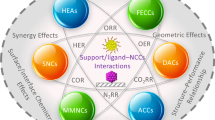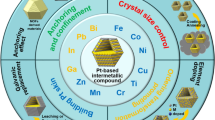Abstract
The low temperature transformation pathways of tungsten carbide formation in the nanoscale regime were investigated using a reactive carbon molecule and tungsten. WC core/W shell nanoparticles produced by the decomposition of metastable W2C were discovered using TEM. XRD studies revealed both the elemental and carbide phases of tungsten. It was observed that the metastable W2C phase can be stabilized at RT by carbon encapsulation. These findings open new avenues to access core-shell morphologies of refractory carbides and to stabilize W2C nanoparticles at RT.





Similar content being viewed by others
References
Y. Li, Y. Gao, B. Xiao, T. Min, Z. Fan, S. Ma, and L. Xu, Theoretical Study on the Stability, Elasticity, Hardness and Electronic Structures of W-C Binary Compounds, J. Alloys Compd., 2010, 502, p 28–37
T.Ya. Kosolapova, Carbides Properties, Production and Applications, Plenum Press, New York, 1971
A.D. Adamczack, A.A. Spriggs, D.M. Fitch, M. Radovic, and J.C. Grunlan, Low-Temperature Formation of Ultra-High-Temperature Transition Metal Carbides from Salt-Polymer Precursors, J. Am. Ceram. Soc., 2010, 93, p 2222–2228
R.L. Levy and M. Boudart, Platinum-Like Behavior of Tungsten Carbide in Surface Catalysis, Science, 1973, 181, p 547–549
L.H. Bennett, J.R. Cuthill, A.J. McAlister, and N.E. Erickson, Electronic and Catalytic Properties of Tungsten Carbide, Science, 1975, 187, p 858–859
G.F. Huttig, V. Fattinger, and K. Kohla, Preparation of Metal Carbides. I, Powder Met. Bull., 1950, 5, p 30–37
W.D. Schubert, Kinetics of the Hydrogen Reduction of Tungsten Oxide, Int. J. Ref. Metals Hard Mater., 1990, 4, p 178–191
G.R. Goren-Muginstein, S. Berger, and A. Rosen, Sintering Study of Nanocrystalline Tungsten Carbide Powders, Nanostruct. Mater., 1998, 10, p 795–804
G.A. Somorjai and N. Materer, Surface Structures in Ammonia Synthesis, Top. Catal., 1994, 1, p 215–231
C. Giordano, C. Erpen, W. Yao, and M. Antonietti, Synthesis of Mo and W Carbide and Nitride Nanoparticles via a Simple “Urea Glass” Route, Nano Lett., 2008, 8, p 4659–4663
D. Chen, H. Wen, H. Zhai, H. Wang, X. Li, R. Zhang, J. Sun, and L. Gao, Novel Synthesis of Hierarchical Tungsten Carbide Micro-/Nanocrystals from a Single-Source Precursor, J. Am. Ceram. Soc., 2010, 93, p 3997–4000
B. Wang, C. Tian, L. Wang, R. Wang, and H. Fu, Chitosan: A Green Carbon Source for the Synthesis of Graphitic Nanocarbon, Tungsten Carbide and Graphitic Nanocarbon/Tungsten Carbide Composites, Nanotechnology, 2010, 21, p 025606/1-9
M. Wu, L. Mu, Y. Wang, Y.-N. Lin, H. Guo, and T. Ma, One-Step Synthesis of Nano-Scaled Tungsten Oxides and Carbides for Dye-Sensitized Solar Cells as Counter Electrode Catalysts, J. Mater. Chem. A, 2013, 1, p 7519–7524
Z. Yan, M. Cai, and P.K. She, Nanosized Tungsten Carbide Synthesized by a Novel Route at Low Temperature for High Performance Electrocatalysis, Sci. Rep. (Nature), 2013, 3, p 1646/1-7
A. Hoseinpur, J.V. Khaki, and M.S. Marashi, Mechanochemical Synthesis of Tungsten Carbide Nano Particles by Using WO3/Zn/C Powder Mixture, Mater. Res. Bull., 2013, 48, p 399–403
M.K. Jones and T.M. Keller, Synthesis and Characterization of Multiple Phenylethynyl-Benzenes via Cross-Coupling with Activated Palladium Catalysts, Polymer, 1995, 36, p 187–192
N.C. Halder and C.N.J. Wagner, Separation of Particle Size and Lattice Strain in Integral Breadth Measurements, Acta Crys., 1966, 20, p 312–313
M.P. Seah, L.S. Gilmore, and G. Beamson, XPS: Binding Energy Calibration of Electron Spetrometers 5-re-evaluation of the Reference Energies, Surf. Interface Anal., 1998, 26, p 642–649
J.H. Scofield, Hartree-Slater Subshell Photionization Cross-Sections at 1254 and 1487 eV, J. Electron Spectrosc. Relat. Phenom., 1976, 8, p 129–137
A. Jablonski and C.J. Powell, The Electron Attenuation Length Revisited, Surf. Sci. Rep., 2002, 47, p 33–91
S. Tanuma, C.J. Powell, and D.R. Penn, Calculations of Electron Inelastic Mean Free Paths. V. Data for 14 Organic Compounds Over the 50-2000 eV Range, Surf. Interface Anal., 1994, 21, p 165–176
K.R. Birdwhistell, T.L. Tonker, and J.L. Templeton, Transformation of a Tungsten(0) Alkyne to a Tungsten(II) Alkyne via Vinylidne, Carbyne, and Ketenyl Ligands, J. Am. Chem. Soc., 1985, 107, p 4474–4483
A.E. Metcalfe, The Mutual Solid Solubility of Tungsten Carbide and Titanium Carbide, J. Inst. Met., 1947, 73, p 591–599
B. Lönnberg, Thermal Expansion Studies on the Subcarbides of Group V and VI, Transition Metals, J. Less-Common Met., 1986, 120, p 135–146
A.W. Hull, X-ray Crystal Analysis of Thirteen Common Metals, Phys. Rev., 1921, 17, p 571–588
N.C. Halder and C.N.J. Wagner, Separation of Particle Size and Lattice Strain in Integral Breadth Measurements, Acta Cryst., 1966, 20, p 312–313
K.L. Hakansson, H.I.P. Johansson, and L.I. Johansson, High Resolution Core-Level Study of Hexagonal WC(0001), Phys. Rev. B, 1994, 49, p 2035–2039
J.F. van der Veen, F.J. Himpsel, and D.E. Eastman, Chemisorption-Induced 4f-core-electron Binding-Energy Shifts for Surface Atoms of W(111), W(100), and Ta(111), Phys. Rev. B, 1982, 25, p 7388–7397
G. Hollinger, T. Minh Duc, and E. Deneuville, Charge Transfer in Amorphous Colored WO3 Films Observed by X-ray Photoelectron Spectroscopy, Phys. Rev. Lett., 1976, 37, p 1564–1567
J. Luthin and Ch Linsmeier, Carbon Films and Carbide Formation on Tungsten, Surf. Sci., 2000, 454–456, p 78–82
K.P. Fears, D.Y. Petrovykh, and T.D. Clark, Evaluating Protocols and Analytical Methods for Peptide Adsorption Experiments, Biointerphases, 2013, 8, p 1–15
Acknowledgments
The authors wish to acknowledge the Office of Naval Research (ONR) for the financial support of this work.
Author information
Authors and Affiliations
Corresponding author
Rights and permissions
About this article
Cite this article
Kolel-Veetil, M.K., Goswami, R., Fears, K.P. et al. Formation and Stability of Metastable Tungsten Carbide Nanoparticles. J. of Materi Eng and Perform 24, 2060–2066 (2015). https://doi.org/10.1007/s11665-015-1476-3
Received:
Revised:
Published:
Issue Date:
DOI: https://doi.org/10.1007/s11665-015-1476-3




